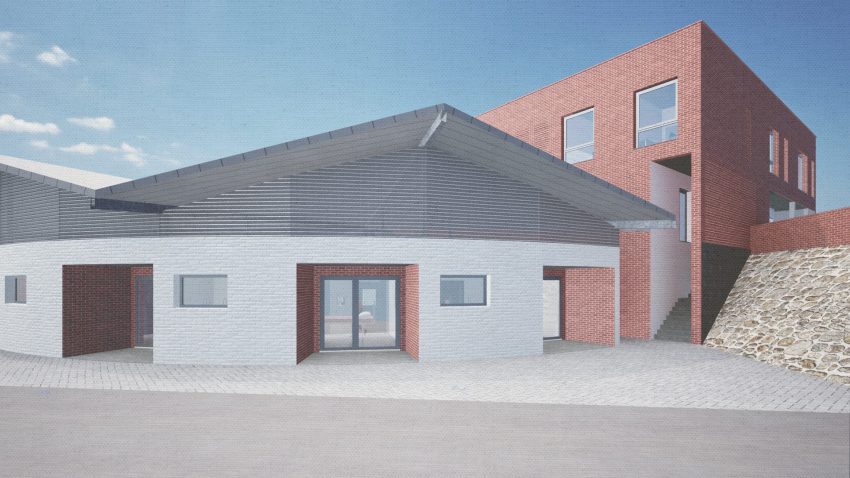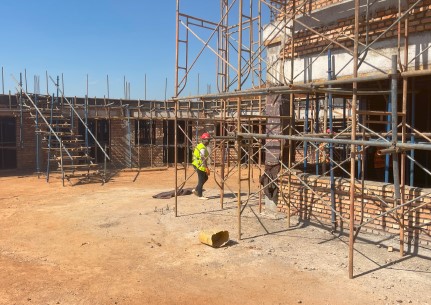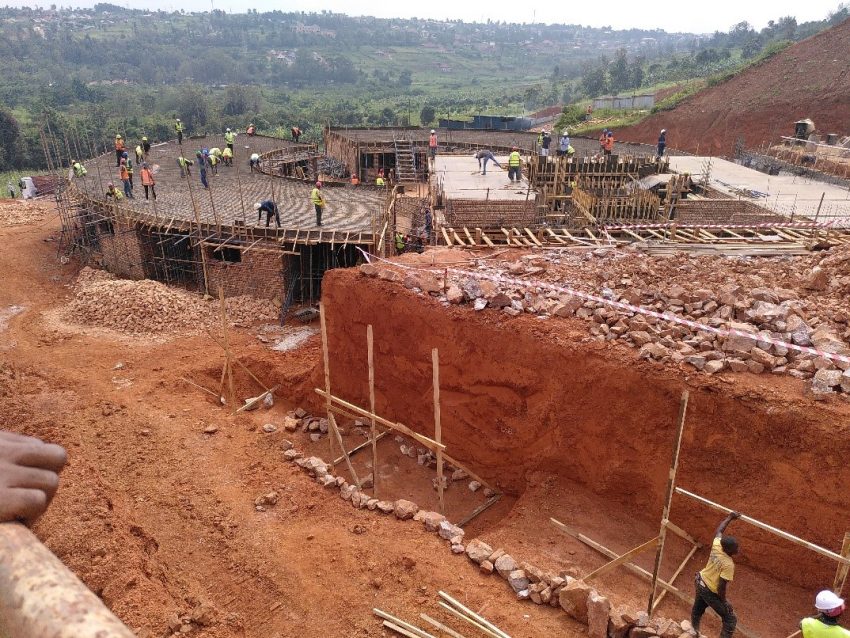Buildings as key players in the combat of high consequence infectious diseases TU Braunschweig is building a High-level Isolation Unit (HLIU) and Training Centre with German and Rwandan partners
Ebola – / Marburg – / Lassaviruses, – in addition to the COVID-19 pandemic, there are other emerging pathogens that can cause life-threatening diseases. Even a few cases of high consequence infectious diseases (HCIDs) can overwhelm inadequately prepared health systems, disrupting essential health services and cause further harm to the population. A key lesson learned from former HCID outbreaks is the need to strengthen local health systems to respond effectively and quickly to outbreaks. For this, even individual cases must be detected, isolated and treated as early as possible.Together with German and Rwandan partners in Rwanda,the Institute of Structural Design, Industrial and Healthcare Construction (IKE) at the Technical University of Braunschweig is building a so-called High-level Isolation Unit (HLIU) with a training centre to treat these cases.

Visualisation of the High-level Isolation Unit /HLIU) in Rwanda. Picture Credit: Institut für Konstruktives Entwerfen, Industrie- und Gesundheitsbau / TU Braunschweig
The 2018-2020 Ebola Disease epidemic in the Democratic Republic of Congo was the second largest ever recorded outbreak. The World Health Organization (WHO) reported more than 3481 cases, including 2299 deaths. Its eastern neighbour, Rwanda, has been classified by the WHO as a high-risk country. Although almost 100% of Rwanda’s population is covered by health insurance and has access to a network of hospitals and health centres spread across the country, the East African country still faces major challenges in infection prevention and control, including a lack of specific structural infrastructure for the isolation, care and treatment of patients with high consequence infectious diseases (HCIDs) and emerging infectious diseases (EIDs).
A key role for buildings
Healthcare facilities where emerging pathogens are spreading also pose a risk to other patients and to the healthcare workers who are crucial in dealing with such emergencies. In the worst case, it can also lead to a loss of public confidence in the healthcare system and HCID patients going undetected. Good building hygiene management is central to dealing with such emergencies: buildings play a key role and therefore have an impact on the quality of medical care and infection control.

Construction Site of the High-level Isolation Unit in Rwanda. Picture Credit: Institut für Konstruktives Entwerfen, Industrie- und Gesundheitsbau/ TU Braunschweig
This is where the Efficiency by Edification Center of Excellence (EFFO-CoE) project, funded by the German Federal Ministry of Health and coordinated by the Robert Koch Institute (RKI), comes in: The planned Center of Excellence (CoE) will serve as a High-level isolation unit (HLIU) and a training center for healthcare workers. The CoE is being constructed near a large hospital in the Rwandan capital, Kigali. Specialist staff will be on site and existing equipment will be used. The Institute for Structural Design, Industrial and Healthcare Construction (IKE) at Technische Universität Braunschweig is responsible for all architectural planning tasks. Over the past 10 years, the institute has developed into a central teaching and research center for healthcare construction in Germany. An interdisciplinary research team with experts from the fields of architecture, process planning and hygiene tackles the complex challenges of future-oriented hospital construction. One area of specialisation in healthcare construction is structural infection prevention. This research encompasses both structural and design decisions, such as the choice of materials and component design solutions. Considerations for optimising process planning, such as ward layouts and operational workflows, are also evaluated at the structural level.
The EFFO Project
The HLIU currently under construction is part of the Efficiency by Edification (Efficace par la Formation/EFFO) project of the RKI. EFFO was developed in 2014 by German, Burkinabe and Senegalese experts. The project was prompted by the devastating Ebola epidemic in West Africa from 2013 to 2016 and focuses on fighting the Ebola virus and strengthening health structures by providing professional training for medical staff. EFFO has been in dialogue with COVID-19 project partners since the beginning of the coronavirus pandemic. The locally trained EFFO trainers have also been using their knowledge and experience from the Ebola training courses in the context of COVID-19. Together with the Rwanda Biomedical Centre (RBC), work is underway to expand the collaboration beyond Ebola and COVID-19 to strengthen the health system for future outbreaks. The project has been an integral part of the German Ministry of Health’s Global Health Protection Programme since 2016.

Construction Site of the High-level Isolation Unit in Rwanda. Picture Credit: Institut für Konstruktives Entwerfen, Industrie- und Gesundheitsbau/ TU Braunschweig
In the EFFO Health Care Facilities (HCF) for Rwanda project (2019-2020), the TU Braunschweig team added an infrastructure package to a training programme for health workers on the care of patients with HCID, which had already been successfully implemented in West Africa in the original EFFO project. Two small isolation units, each with four patient rooms, its own access road, supply and disposal facilities, etc., were built at the Rwanda Military Hospital in Kigali and the Kibirizi District Hospital. Due to the development immediately upon completion in 2020, both were used to combat the coronavirus pandemic.
High Level Isolation Unit and Training Centre
The site of the CoE is part of the emerging medical hub, Kigali Health City, where several of Rwanda’s health and university institutions will be located. The essential innovation regarding the Centre of Excellence is the fact that HCID patients are not only to be isolated but are to receive comprehensive medical treatment, including full intensive care. This will make the CoE only the second treatment centre of its kind in Africa.

Construction Site of the High-level Isolation Unit in Rwanda. Picture Credit: Institut für Konstruktives Entwerfen, Industrie- und Gesundheitsbau/ TU Braunschweig
By April 2025, we will have constructed a building whose circular design not only blends in perfectly with the region, but also allows the 10 isolation rooms to be used in such a way as to minimise the risk of infection. The rooms comparable in size and equipment to an intensive care room each have access from the outside as well as access for medical resources via special preparation anterooms inside. Patients can therefore be brought into the isolation rooms as soon as they arrive without possible contamination of other areas in the CoE. Furthermore, they do not have to leave the room even for examinations or treatment. All procedures can be carried out directly in the patient’s room as to prevent the spread of pathogens. The layout of the patient area is designed to respond flexibly to different types of infections. If all patients hospitalized in the HLIU are infected with the same pathogen, donning of the personal protective equipment (PPE) and decontamination with subsequent doffing of PPE is carried out in centralised areas. If the patients are infected with different pathogens, donning, decontamination and doffing will take place in the anterooms.

Floorplan of Patientlevel. Picture Credit: Institut für Konstruktives Entwerfen, Industrie- und Gesundheitsbau/ TU Braunschweig
Whenever feasible, local materials were used in the construction of the buildings, in order to optimize cost-effectiveness and sustainability as well as to increase acceptance of the Centre.
In order to define the requirements of the CoE with the local partner, a delegation from RBC visited German high-level isolation units in Berlin, Hamburg and Düsseldorf in April 2022. The dialogue with the future users was and still is particularly important. On the one hand, in order to be able to respond to the special requirements on site, and on the other hand, there is enormous potential to gain knowledge for further research and development of healthcare buildings from the experiences of local experts in dealing with HCIDs and EIDs.
Under the coordination of the RKI project partners such as the RBC, Charité Berlin and Medmissio Würzburg are already working on HCID training programmes during the construction phase. A particular feature of the new HLIU is a special training room. Here, medical staff can follow the training programmes through a window and thus learn in practice. The training programmes developed here and the specialists trained on site are intended to ensure that the expertise gained can also be applied in other countries through train the trainer programmes.
Trial operations are scheduled to begin in April 2025 and the CoE is expected to be approved for regular operations the following summer.
